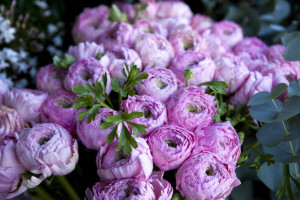 Spring and summer are show time for gardeners, especially flower gardeners. Careful planning and loving labor invested in the fall and early parts of spring burst forth into glorious display as the weather warms. Some of the first stars to appear onstage are peonies. These lush plants with large blooms make a splashy entrance and invite expectation of the later flowers to follow.
Spring and summer are show time for gardeners, especially flower gardeners. Careful planning and loving labor invested in the fall and early parts of spring burst forth into glorious display as the weather warms. Some of the first stars to appear onstage are peonies. These lush plants with large blooms make a splashy entrance and invite expectation of the later flowers to follow.
Technically known as paeonia suffruticosa, peonies explode into bloom near the end of spring and will produce fabulous flowers for the next six weeks. Each individual blossom will last about seven days. Peonies are perennials meaning they will be back year after year producing generous blooms, gentle fragrance and lush green leaves. The flowers make a terrific staple in a cut flower garden though you should avoid cutting more than one-third to one-half of blooms so that your plant will continue to produce new blooms. Place markers for peonies in your garden to identify each variety.
Peonies also appear to advantage along a border since even after their blooms disappear their green foliage is attractive. Since they come in a variety of colors (with the exception of blues) you can have fun creating a visual display in the yard and in a vase indoors. Just be sure to plant them in a location with partial to full sun and soil that drains well.
Garden peonies grow as bushes and reach about two to four feet in height while the tree variety can climb up to 10 feet tall. These flowers prefer cool northern climates. Winter cold will help produce showy blooms in spring. So if you live in an area hospitable to these beauties, make the most of it.
The plants are generally disease and pest-resistant. However, if you notice problems you need only remove affected leaves and try an antifungal treatment. Ladybugs are your friend in this matter. Welcome them into your garden.
The most popular varieties of peonies are colorful and hardy. You may want to try several kinds and place markers for peonies in front of each variety to see which you like best.
- Early blooming hybrids will produce a single bloom on each stem. Look for Do Tell and Coral Charm
- Intersectional peonies are a mix of tree and bush varieties. Popular choices are Cora Louise and Garden Treasure
- Lactiflora are the peonies most popular at local plant nurseries. These will produce multiple blooms per stem. Dark Purple Silk is a striking and popular choice
- If you’re game to try the tree peony consider planting Black Dragon Brocade
Peonies will thrive and yield blooms for many years with little attention. In early spring feed soil with a fertilizer without too much nitrogen as heavy nitrogen can lead to plant weakness and fewer blooms. After 10 years if you notice not as many blossoms appearing it’s probably time to dig up the roots and divide the plant. When you find a new home for your root ball be sure to use markers for peonies to identify which varieties are located where in your garden plan.
When choosing markers for peonies or any of your garden flowers, take a look at Kincaid Plant Markers. Like the long-lasting peony, our markers are durable year after year. They are the choice markers of expert gardeners and hobbyists interested in sharing the intricacies of gardening with others.
